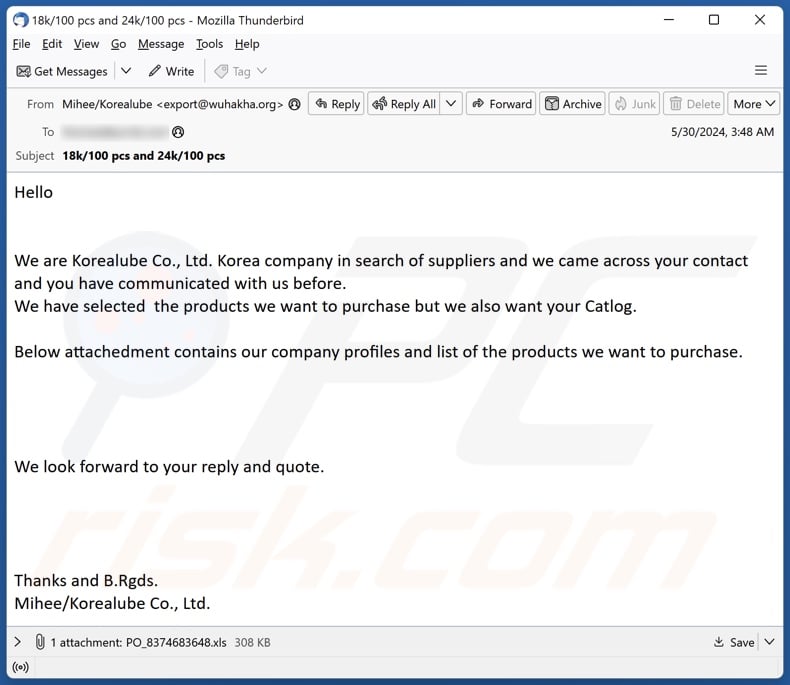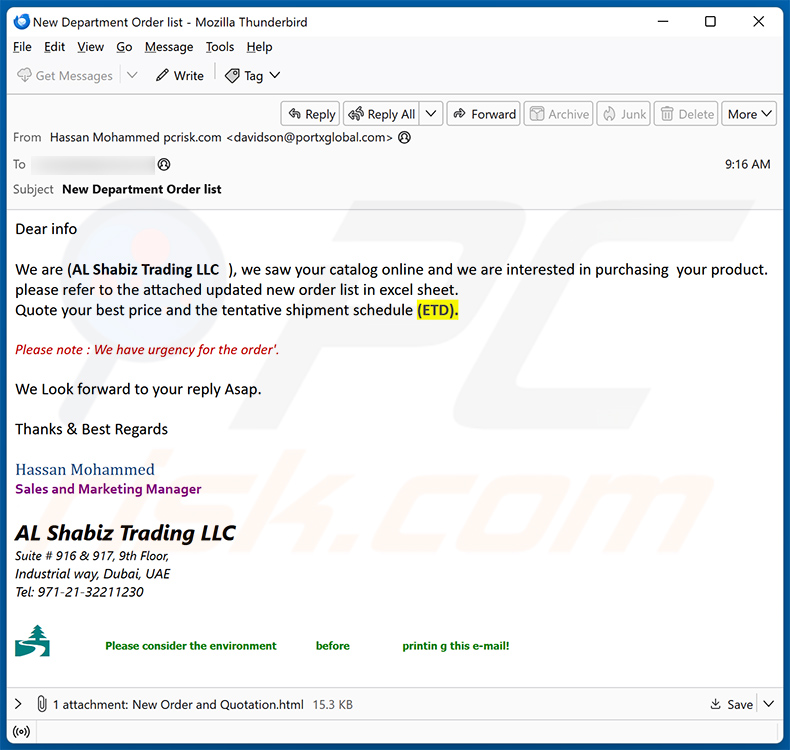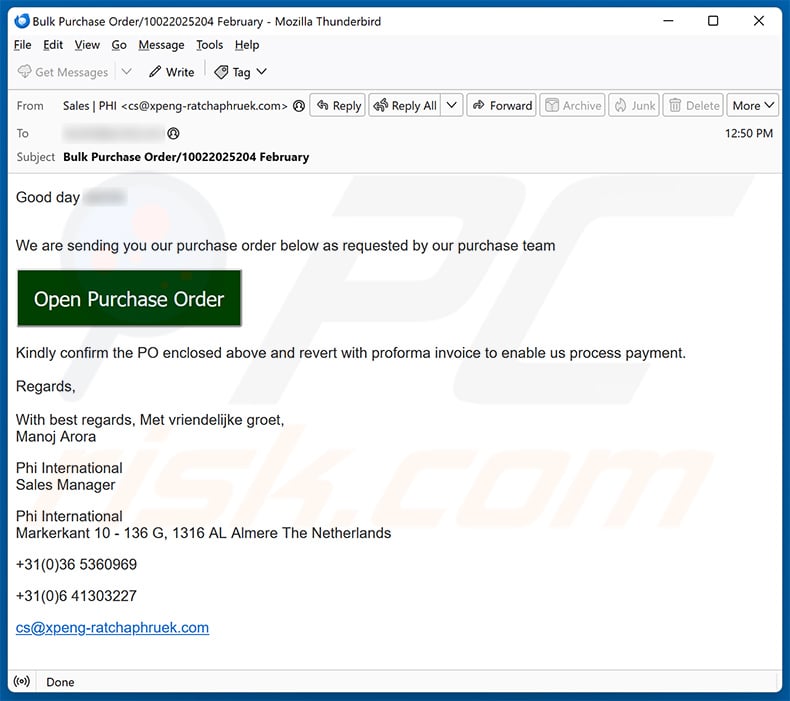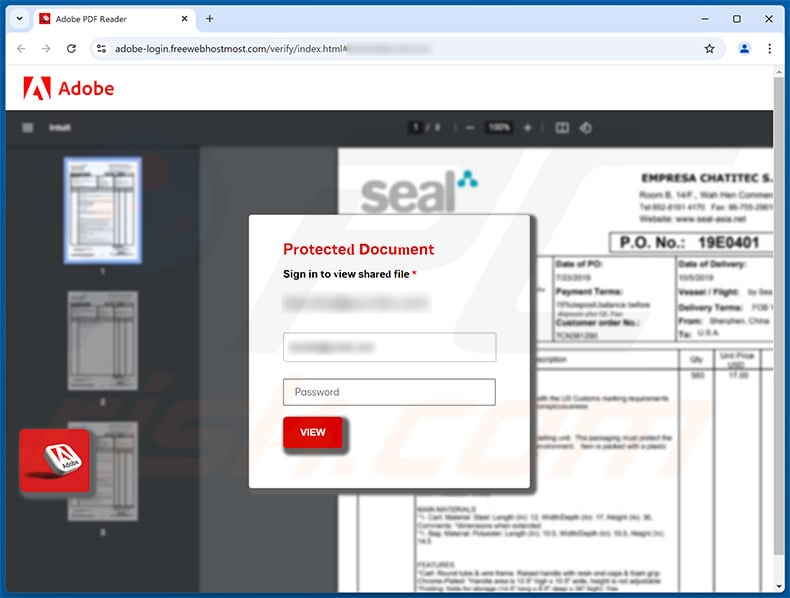Avoid infecting your system via fake "Products We Want To Purchase" emails
Phishing/ScamAlso Known As: "Products We Want To Purchase" malspam
Get free scan and check if your device is infected.
Remove it nowTo use full-featured product, you have to purchase a license for Combo Cleaner. Seven days free trial available. Combo Cleaner is owned and operated by RCS LT, the parent company of PCRisk.com.
What kind of email is "Products We Want To Purchase"?
After investigating this "Products We Want To Purchase" email, we determined that it is malspam. This spam letter is presented as a potential purchase inquiry. Its attachment supposedly details the sought-after products, but instead, it is designed to infect recipients' devices with the Agent Tesla RAT (Remote Access Trojan).

"Products We Want To Purchase" email virus overview
The spam email with the subject "18k/100 pcs and 24k/100 pcs" (may vary) claims to be a message from a Korean company. Allegedly, the recipient has had previous dealings with the sender. The letter expresses an interest in a purchase from the recipient.
As mentioned in the introduction, the information in this email is false, and this mail is not associated with any legitimate companies or other entities.
According to the scam email, its attachment contains the sender's company profiles and lists of the products they are interested in purchasing. The attached Microsoft Excel document is designed to infect systems with Agent Tesla. The malware's download/installation is triggered when a victim opens the file and enables its macro commands (editing).
Agent Tesla is a RAT (Remote Access Trojan), and as such – it is designed to allow remote access/control over machines. Additionally, this malicious program has various data-stealing capabilities.
In summary, by trusting an email like "Products We Want To Purchase" – users can experience system infections, serious privacy issues, financial losses, and identity theft.
If you believe that your device is already infected – perform a full system scan with an anti-virus and remove all detected threats.
| Name | "Products We Want To Purchase" malspam |
| Threat Type | Malspam, malicious spam, spam, malware, Trojan. |
| Fake Claim | Sender is interested in purchasing products from the recipient. |
| Attachment(s) | PO_8374683648.xls (filename may vary) |
| Detection Names | Avast (Other:Malware-gen [Trj]), Combo Cleaner (Trojan.GenericKD.72926213), ESET-NOD32 (DOC/TrojanDownloader.Agent.FDE), Kaspersky (HEUR:Trojan-Downloader.MSOffice.SLoad.g), Microsoft (Exploit:O97M/CVE-2017-0199.CXT), Full List Of Detections (VirusTotal) |
| Payload | Agent Tesla |
| Symptoms | Trojans are designed to stealthily infiltrate the victim's computer and remain silent, and thus no particular symptoms are clearly visible on an infected machine. |
| Distribution methods | Infected email attachments, malicious online advertisements, social engineering, software 'cracks'. |
| Damage | Stolen passwords and banking information, identity theft, the victim's computer added to a botnet. |
| Malware Removal (Windows) |
To eliminate possible malware infections, scan your computer with legitimate antivirus software. Our security researchers recommend using Combo Cleaner. Download Combo CleanerTo use full-featured product, you have to purchase a license for Combo Cleaner. 7 days free trial available. Combo Cleaner is owned and operated by RCS LT, the parent company of PCRisk.com. |
Malspam campaign examples
"Interpol", "Messages In Soundbox", "Quotation Request", "Urgent Requirement For The Supply", "Confirm Hotel Bank Account", and "Rooming List For The Group" are just some of our newest articles on malspam.
These emails proliferate all kinds of malware – various trojan-types, ransomware, cryptocurrency miners, etc. Additionally, spam letters are used to promote scams, such as phishing, sextortion, tech support, refund, lottery, inheritance, and others.
Due to how widespread spam mail is and how well-made it can be – we strongly recommend being vigilant with incoming emails, DMs/PMs, SMSes, and other messages.
How do spam campaigns infect computers?
The "Products We Want To Purchase" email we inspected had a malicious Microsoft Excel file attached to it. This file initiates the process for infiltrating Agent Tesla into systems once it is opened and its macros are enabled.
It is noteworthy that spam mail proliferates malware through varied format files, which can be attached to or linked inside the emails/messages. Infectious files can be documents (Microsoft Office, Microsoft OneNote, PDF, etc.), executables (.exe, .run, etc.), archives (RAR, ZIP, etc.), JavaScript, and so on.
While for some formats, merely opening them is enough to trigger malware download/installation chains, others require additional user interaction (e.g., enabling macro commands, clicking embedded files/links, etc.).
How to avoid installation of malware?
We recommend treating incoming emails and other messages with care. Attachments or links in dubious/irrelevant mail must not be opened, as they can be virulent. Another recommendation is to use Microsoft Office versions released after 2010 since they have the "Protected View" mode that prevents automatic macro execution.
However, malware is not distributed only through spam mail. Therefore, we advise vigilance while browsing, as fraudulent and malicious online content typically appears legitimate and innocuous.
Furthermore, all downloads must be performed from official and trustworthy sources. Additionally, software must be activated using functions/tools provided by genuine developers, as illegal activation ("cracking") tools and third-party updates can contain malware.
It is essential to have a dependable anti-virus installed and kept updated. Security programs must be used to perform regular system scans and to remove threats and issues. If you've already opened malicious attachments, we recommend running a scan with Combo Cleaner Antivirus for Windows to automatically eliminate infiltrated malware.
Text presented in the "Products We Want To Purchase" email letter:
Subject: 18k/100 pcs and 24k/100 pcs
Hello
We are Korealube Co., Ltd. Korea company in search of suppliers and we came across your contact and you have communicated with us before.
We have selected the products we want to purchase but we also want your Catlog.
Below attachedment contains our company profiles and list of the products we want to purchase.
We look forward to your reply and quote.
Thanks and B.Rgds.
Mihee/Korealube Co., Ltd.
Screenshot of the malicious attachment distributed via this spam campaign ("PO_8374683648.xls"):

Another example of an email from "Products We Want To Purchase" spam campaign:

Text presented within:
Subject: New Department Order list
Dear -
We are (AL Shabiz Trading LLC ), we saw your catalog online and we are interested in purchasing your product.
please refer to the attached updated new order list in excel sheet.
Quote your best price and the tentative shipment schedule (ETD).
Please note : We have urgency for the order'.
We Look forward to your reply Asap.
Thanks & Best Regards
Hassan Mohammed
Sales and Marketing Manager
AL Shabiz Trading LLC
Suite # 916 & 917, 9th Floor,
Industrial way, Dubai, UAE
Tel: 971-21-32211230
Screenshot of the attached HTML file used for phishing purposes:

Another example of an email from "Products We Want To Purchase" spam campaign:

Text presented within:
Subject: Bulk Purchase Order/10022025204 February
Good day -
We are sending you our purchase order below as requested by our purchase team
Kindly confirm the PO enclosed above and revert with proforma invoice to enable us process payment.
Regards,
With best regards, Met vriendelijke groet,
Manoj AroraPhi International
Sales ManagerPhi International
Markerkant 10 - 136 G, 1316 AL Almere The Netherlands+31(0)36 5360969
+31(0)6 41303227
cs@xpeng-ratchaphruek.com
Screenshot of the promoted phishing site:

Instant automatic malware removal:
Manual threat removal might be a lengthy and complicated process that requires advanced IT skills. Combo Cleaner is a professional automatic malware removal tool that is recommended to get rid of malware. Download it by clicking the button below:
DOWNLOAD Combo CleanerBy downloading any software listed on this website you agree to our Privacy Policy and Terms of Use. To use full-featured product, you have to purchase a license for Combo Cleaner. 7 days free trial available. Combo Cleaner is owned and operated by RCS LT, the parent company of PCRisk.com.
Quick menu:
- What is "Products We Want To Purchase" malspam?
- Types of malicious emails.
- How to spot a malicious email?
- What to do if you fell for an email scam?
Types of malicious emails:
![]() Phishing Emails
Phishing Emails
Most commonly, cybercriminals use deceptive emails to trick Internet users into giving away their sensitive private information, for example, login information for various online services, email accounts, or online banking information.
Such attacks are called phishing. In a phishing attack, cybercriminals usually send an email message with some popular service logo (for example, Microsoft, DHL, Amazon, Netflix), create urgency (wrong shipping address, expired password, etc.), and place a link which they hope their potential victims will click on.
After clicking the link presented in such email message, victims are redirected to a fake website that looks identical or extremely similar to the original one. Victims are then asked to enter their password, credit card details, or some other information that gets stolen by cybercriminals.
![]() Emails with Malicious Attachments
Emails with Malicious Attachments
Another popular attack vector is email spam with malicious attachments that infect users' computers with malware. Malicious attachments usually carry trojans that are capable of stealing passwords, banking information, and other sensitive information.
In such attacks, cybercriminals' main goal is to trick their potential victims into opening an infected email attachment. To achieve this goal, email messages usually talk about recently received invoices, faxes, or voice messages.
If a potential victim falls for the lure and opens the attachment, their computers get infected, and cybercriminals can collect a lot of sensitive information.
While it's a more complicated method to steal personal information (spam filters and antivirus programs usually detect such attempts), if successful, cybercriminals can get a much wider array of data and can collect information for a long period of time.
![]() Sextortion Emails
Sextortion Emails
This is a type of phishing. In this case, users receive an email claiming that a cybercriminal could access the webcam of the potential victim and has a video recording of one's masturbation.
To get rid of the video, victims are asked to pay a ransom (usually using Bitcoin or another cryptocurrency). Nevertheless, all of these claims are false - users who receive such emails should ignore and delete them.
How to spot a malicious email?
While cyber criminals try to make their lure emails look trustworthy, here are some things that you should look for when trying to spot a phishing email:
- Check the sender's ("from") email address: Hover your mouse over the "from" address and check if it's legitimate. For example, if you received an email from Microsoft, be sure to check if the email address is @microsoft.com and not something suspicious like @m1crosoft.com, @microsfot.com, @account-security-noreply.com, etc.
- Check for generic greetings: If the greeting in the email is "Dear user", "Dear @youremail.com", "Dear valued customer", this should raise suspiciousness. Most commonly, companies call you by your name. Lack of this information could signal a phishing attempt.
- Check the links in the email: Hover your mouse over the link presented in the email, if the link that appears seems suspicious, don't click it. For example, if you received an email from Microsoft and the link in the email shows that it will go to firebasestorage.googleapis.com/v0... you shouldn't trust it. It's best not to click any links in the emails but to visit the company website that sent you the email in the first place.
- Don't blindly trust email attachments: Most commonly, legitimate companies will ask you to log in to their website and to view any documents there; if you received an email with an attachment, it's a good idea to scan it with an antivirus application. Infected email attachments are a common attack vector used by cybercriminals.
To minimise the risk of opening phishing and malicious emails we recommend using Combo Cleaner Antivirus for Windows.
Example of a spam email:

What to do if you fell for an email scam?
- If you clicked on a link in a phishing email and entered your password - be sure to change your password as soon as possible. Usually, cybercriminals collect stolen credentials and then sell them to other groups that use them for malicious purposes. If you change your password in a timely manner, there's a chance that criminals won't have enough time to do any damage.
- If you entered your credit card information - contact your bank as soon as possible and explain the situation. There's a good chance that you will need to cancel your compromised credit card and get a new one.
- If you see any signs of identity theft - you should immediately contact the Federal Trade Commission. This institution will collect information about your situation and create a personal recovery plan.
- If you opened a malicious attachment - your computer is probably infected, you should scan it with a reputable antivirus application. For this purpose, we recommend using Combo Cleaner Antivirus for Windows.
- Help other Internet users - report phishing emails to Anti-Phishing Working Group, FBI’s Internet Crime Complaint Center, National Fraud Information Center and U.S. Department of Justice.
Frequently Asked Questions (FAQ)
Why did I receive this email?
Spam emails are not personal, even if they include details relevant to the recipients. This mail is distributed in massive operations – hence, thousands of users receive identical (or incredibly similar) emails.
I have read a spam email but didn't open the attachment, is my computer infected?
No, merely opening/reading an email is harmless. Systems are infected when malicious attachments or links are opened/clicked.
I have downloaded and opened a file attached to a spam email, is my computer infected?
If the opened file was an executable (.exe, .run, etc.) – most likely, yes – your device was compromised. However, you might have avoided this if it was a document (.doc, .xls, .one, .pdf, etc.). These formats may need additional actions to initiate malware download/installation processes (e.g., enabling macros, clicking embedded content, etc.).
Will Combo Cleaner remove malware infections present in email attachments?
Yes, Combo Cleaner can detect and remove practically all known malware infections. It must be stressed that running a complete system scan is crucial since high-end malicious software tends to hide deep within systems.
Share:

Tomas Meskauskas
Expert security researcher, professional malware analyst
I am passionate about computer security and technology. I have an experience of over 10 years working in various companies related to computer technical issue solving and Internet security. I have been working as an author and editor for pcrisk.com since 2010. Follow me on Twitter and LinkedIn to stay informed about the latest online security threats.
PCrisk security portal is brought by a company RCS LT.
Joined forces of security researchers help educate computer users about the latest online security threats. More information about the company RCS LT.
Our malware removal guides are free. However, if you want to support us you can send us a donation.
DonatePCrisk security portal is brought by a company RCS LT.
Joined forces of security researchers help educate computer users about the latest online security threats. More information about the company RCS LT.
Our malware removal guides are free. However, if you want to support us you can send us a donation.
Donate
▼ Show Discussion